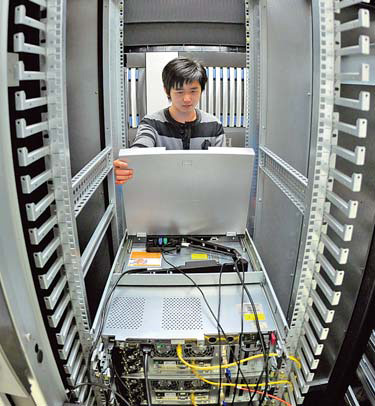Focus
World's fastest computer brings incalculable benefits
By Zhou Wa (China Daily)
Updated: 2010-12-08 08:00
 |
Large Medium Small |
Tianhe-1A makes fast work of ensuring safety of national projects. Zhou Wa in Beijing reports.
Wang Litao read the numbers on his computer screen and sat back, delighted.
The researcher, who was studying the damage Xiluodu Dam could withstand in an earthquake, had waited a month for the outcome of his team's complex simulations - but after entering his equation into Tianhe-1A, his results took just one hour.
Using the fastest supercomputer in the world, experts like Wang at the China Institute of Water Resources and Hydropower Research (IWHR) can help ensure the hydroelectric dam is stronger and safer for the millions who live along Jinsha River.
"The process has been shortened significantly allowing us to offer and analyze more solutions in the same amount of time," said Wang. "We can offer solutions faster to improve safety."
The dam is one of thousands of projects that will benefit from Tianhe-1A (named after the Milky Way), from research in geology, meteorology and medicine, to commercial design, construction and manufacturing.
"It could even save people's lives," said Wang, who explained that, in a landslide, the supercomputer could calculate where reinforcements are needed and what areas should be evacuated.
Xiluodu Dam, which is being constructed on Southwest China's Sichuan-Yunnan provincial boundary, is a key part of ambitious plans to build China's second largest hydropower plant. Once in operation, it will generate 12,600 megawatts of electricity.
As the area is prone to earthquakes, however, engineers must ensure it can survive a major eruption. If not, the water in its reservoir will flood every nearby city and village.
"What's worse, a flood from the upper reaches could even lead to the bursting of the Three Gorges Dam," said Wang, threatening the lives and property of 400 million inhabitants along the Yangtze.
"To avoid this disaster, we need to build a safer dam," he added.
The large capacity of Tianhe-1A - 2.57 petaflops, or quadrillion calculations per second - allows researchers to solve equations with far more variables, making their measurement more accurate.
Even without testing the supercomputer to the full, Wang was able to use a program that answered an equation with 500,000 unknown numbers.
Developed by the National University of Defense Technology (NUDT) in Hunan's provincial capital, Changsha, Tianhe-1A is also a boon for big business.
As in the case of Xiluodu, experts say the machine will help workers in commercial research and development departments find ways to improve the precision and manufacture of products, giving them a greater competitive edge.
Tianjin Motor Dies Co Ltd, which designs and manufactures car body panels and large stamping parts, is the largest of its kind in China and sells to auto giants like General Motors, Ford and BMW.
After employing Tianhe-1A to simulate its stamping process, "we expect to raise our market share" and "make the transition from offering low-end to the high-end products", explained Chen Huibin, one of Tianjin Motor Dies' experts in computer-aided engineering.
Thanks to the simulation, the company will save at least 450,000 yuan, or 3 percent of costs in producing automobile side panels.
"It's a large saving," said Chen, "because our profit margins are only about 20-percent profit."
Hu Qingfeng, deputy chief designer of Tianhe-1A, which is based at the National Supercomputer Center in Tianjin, said the supercomputer will also speed up manufacture of aircraft's core units using Chinese intellectual property.
Engineers can simulate wind tunnel trials and study the combustion process inside aircraft engines.
